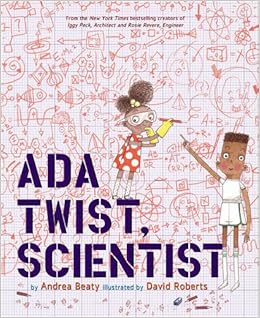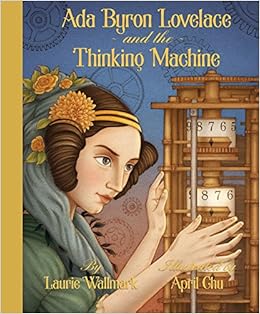I missed many, many great children's books about science in my previous post, so I decided to re-visit the topic with my son. Here, I have chosen books that highlight the most important traits to nourish in budding scientists: asking questions, making observations, forming hypotheses, and remaining persistent.
 Ada Twist, Scientist: I had enjoyed Andrea Beatty's previous books so much that I decided to treat myself to this book (usually I borrow children's books from the Boston Public Library to save money and shelf space). We both found this book worth the purchase. The main character, Ada Marie Twist (named after Ada Lovelace and Marie Curie) is a young girl with an insatiable curiosity. Like her predecessor, Rosie Revere Engineer, who taught kids about the importance of persistence and troubleshooting in engineering, Ada teaches kids about the value of asking questions. I love that Ada's parents are totally game for her questioning and give her space to explore- definitely a vital trait for good science parents.
Ada Twist, Scientist: I had enjoyed Andrea Beatty's previous books so much that I decided to treat myself to this book (usually I borrow children's books from the Boston Public Library to save money and shelf space). We both found this book worth the purchase. The main character, Ada Marie Twist (named after Ada Lovelace and Marie Curie) is a young girl with an insatiable curiosity. Like her predecessor, Rosie Revere Engineer, who taught kids about the importance of persistence and troubleshooting in engineering, Ada teaches kids about the value of asking questions. I love that Ada's parents are totally game for her questioning and give her space to explore- definitely a vital trait for good science parents.
 Ada Byron Lovelace and the Thinking Machine: Another great find! This book details the life and work of Ada Byron Lovelace. Abandoned by her father, the poet Lord Byron, Ada was lucky to have a mother with the financial means to encourage her interest in math. An early bout with measles left Ada paralyzed for some time (confusingly, the book never clarifies what happened here and left me with the impression that Ada was paralyzed for life). Ada's tutors opened her to a world inaccessible to most young women of her time. In her early twenties, her tutor Mary Somerville introduced Ada to Charles Babbage. Ada collaborated with Babbage on several projects, eventually putting together notes that outlined the first computer and computer program. I admit that I have not read that much about Ada Lovelace, so this book was a revelation for me. For me, Ada was uniquely positioned to enter the realm of science and math because her family had the means to encourage her interests. Surprisingly, the income barrier in science persists, even while other fields have become more accessible.
Ada Byron Lovelace and the Thinking Machine: Another great find! This book details the life and work of Ada Byron Lovelace. Abandoned by her father, the poet Lord Byron, Ada was lucky to have a mother with the financial means to encourage her interest in math. An early bout with measles left Ada paralyzed for some time (confusingly, the book never clarifies what happened here and left me with the impression that Ada was paralyzed for life). Ada's tutors opened her to a world inaccessible to most young women of her time. In her early twenties, her tutor Mary Somerville introduced Ada to Charles Babbage. Ada collaborated with Babbage on several projects, eventually putting together notes that outlined the first computer and computer program. I admit that I have not read that much about Ada Lovelace, so this book was a revelation for me. For me, Ada was uniquely positioned to enter the realm of science and math because her family had the means to encourage her interests. Surprisingly, the income barrier in science persists, even while other fields have become more accessible.
 Manfish: A Story of Jacques Cousteau: My introduction to science as a child relied on a healthy dose of Jacques Cousteau (as well as Carl Sagan and Mr. Wizard, of course). I loved how this book captured the magic of the world of the ocean as seen through the eyes of Cousteau. Manfish focuses on the need for asking questions and the importance of imagination and hard work. In particular, we learn how Cousteau and his partner Emilie Gagnan invented scuba tanks and gear to enable Cousteau to explore the ocean as never before. Cousteau also loved filmmaking from an early age, which proved critical for his success as a science educator and conservation activist.
Manfish: A Story of Jacques Cousteau: My introduction to science as a child relied on a healthy dose of Jacques Cousteau (as well as Carl Sagan and Mr. Wizard, of course). I loved how this book captured the magic of the world of the ocean as seen through the eyes of Cousteau. Manfish focuses on the need for asking questions and the importance of imagination and hard work. In particular, we learn how Cousteau and his partner Emilie Gagnan invented scuba tanks and gear to enable Cousteau to explore the ocean as never before. Cousteau also loved filmmaking from an early age, which proved critical for his success as a science educator and conservation activist.
 The Watcher: Jane Goodall: As a child, Jane Goodall loved to watch animals, she dreamed that she could talk to animals like Dr. Doolittle. After graduation, Jane saved up her money to travel to Kenya, where she wanted to work with animals. She was lucky enough to meet Louis Leakey, who gave her a job watching and studying chimps. Despite her lack of scientific training, Goodall revolutionized how ecologist studied their subjects, using an approach that involved long and careful watching and note taking without disturbing the subjects. The book highlights the importance of observation and patience for a scientist.
The Watcher: Jane Goodall: As a child, Jane Goodall loved to watch animals, she dreamed that she could talk to animals like Dr. Doolittle. After graduation, Jane saved up her money to travel to Kenya, where she wanted to work with animals. She was lucky enough to meet Louis Leakey, who gave her a job watching and studying chimps. Despite her lack of scientific training, Goodall revolutionized how ecologist studied their subjects, using an approach that involved long and careful watching and note taking without disturbing the subjects. The book highlights the importance of observation and patience for a scientist.

Mesmerized: How Ben Franklin Solved the Mystery that Baffled all of France was a book that we both enjoyed more than expected! The book details how Ben Franklin, while in France negotiating with Louis XVI for support of the American Revolution, did some scientific investigation of the Mesmer phenomenon. Because our son is presently obsessed with Hamilton, he was excited for some additional details about Lafayette and the French support of the Revolution. We both enjoyed getting some new information about Ben Franklin's fascinating life (he wore a fur hat to cover his bald spot and was a minor celebrity due to his kite experiment). Mesmer had most of France under his spell, until Ben Franklin used the scientific method to investigate. (Critique for the author: the final step in the scientific method should be "make conclusions" not "support your hypothesis"; we need to ensure that future scientists are not cherry pickers that are only interested in positive results!) Interestingly, the Mesmer phenomenon revealed the placebo effect and Franklin's approach to the problem formed the basis for later drug trial designs.

The Elements:A Visual Exploration of Every Known Atom in the Universe was recommended in a post about great science books for kids. It is a great reference book for a wide range of ages; whether your kids are just learning about the periodic table or if they want to learn more. This picture book includes a variety of photos associated with each elements as well as fun and interesting trivia. The author, who is an element collector, shares his love of the elements in a novel way. This one is also available as an iPad app, which is on my list to check out.
 Ada Twist, Scientist: I had enjoyed Andrea Beatty's previous books so much that I decided to treat myself to this book (usually I borrow children's books from the Boston Public Library to save money and shelf space). We both found this book worth the purchase. The main character, Ada Marie Twist (named after Ada Lovelace and Marie Curie) is a young girl with an insatiable curiosity. Like her predecessor, Rosie Revere Engineer, who taught kids about the importance of persistence and troubleshooting in engineering, Ada teaches kids about the value of asking questions. I love that Ada's parents are totally game for her questioning and give her space to explore- definitely a vital trait for good science parents.
Ada Twist, Scientist: I had enjoyed Andrea Beatty's previous books so much that I decided to treat myself to this book (usually I borrow children's books from the Boston Public Library to save money and shelf space). We both found this book worth the purchase. The main character, Ada Marie Twist (named after Ada Lovelace and Marie Curie) is a young girl with an insatiable curiosity. Like her predecessor, Rosie Revere Engineer, who taught kids about the importance of persistence and troubleshooting in engineering, Ada teaches kids about the value of asking questions. I love that Ada's parents are totally game for her questioning and give her space to explore- definitely a vital trait for good science parents. Ada Byron Lovelace and the Thinking Machine: Another great find! This book details the life and work of Ada Byron Lovelace. Abandoned by her father, the poet Lord Byron, Ada was lucky to have a mother with the financial means to encourage her interest in math. An early bout with measles left Ada paralyzed for some time (confusingly, the book never clarifies what happened here and left me with the impression that Ada was paralyzed for life). Ada's tutors opened her to a world inaccessible to most young women of her time. In her early twenties, her tutor Mary Somerville introduced Ada to Charles Babbage. Ada collaborated with Babbage on several projects, eventually putting together notes that outlined the first computer and computer program. I admit that I have not read that much about Ada Lovelace, so this book was a revelation for me. For me, Ada was uniquely positioned to enter the realm of science and math because her family had the means to encourage her interests. Surprisingly, the income barrier in science persists, even while other fields have become more accessible.
Ada Byron Lovelace and the Thinking Machine: Another great find! This book details the life and work of Ada Byron Lovelace. Abandoned by her father, the poet Lord Byron, Ada was lucky to have a mother with the financial means to encourage her interest in math. An early bout with measles left Ada paralyzed for some time (confusingly, the book never clarifies what happened here and left me with the impression that Ada was paralyzed for life). Ada's tutors opened her to a world inaccessible to most young women of her time. In her early twenties, her tutor Mary Somerville introduced Ada to Charles Babbage. Ada collaborated with Babbage on several projects, eventually putting together notes that outlined the first computer and computer program. I admit that I have not read that much about Ada Lovelace, so this book was a revelation for me. For me, Ada was uniquely positioned to enter the realm of science and math because her family had the means to encourage her interests. Surprisingly, the income barrier in science persists, even while other fields have become more accessible. Manfish: A Story of Jacques Cousteau: My introduction to science as a child relied on a healthy dose of Jacques Cousteau (as well as Carl Sagan and Mr. Wizard, of course). I loved how this book captured the magic of the world of the ocean as seen through the eyes of Cousteau. Manfish focuses on the need for asking questions and the importance of imagination and hard work. In particular, we learn how Cousteau and his partner Emilie Gagnan invented scuba tanks and gear to enable Cousteau to explore the ocean as never before. Cousteau also loved filmmaking from an early age, which proved critical for his success as a science educator and conservation activist.
Manfish: A Story of Jacques Cousteau: My introduction to science as a child relied on a healthy dose of Jacques Cousteau (as well as Carl Sagan and Mr. Wizard, of course). I loved how this book captured the magic of the world of the ocean as seen through the eyes of Cousteau. Manfish focuses on the need for asking questions and the importance of imagination and hard work. In particular, we learn how Cousteau and his partner Emilie Gagnan invented scuba tanks and gear to enable Cousteau to explore the ocean as never before. Cousteau also loved filmmaking from an early age, which proved critical for his success as a science educator and conservation activist. The Watcher: Jane Goodall: As a child, Jane Goodall loved to watch animals, she dreamed that she could talk to animals like Dr. Doolittle. After graduation, Jane saved up her money to travel to Kenya, where she wanted to work with animals. She was lucky enough to meet Louis Leakey, who gave her a job watching and studying chimps. Despite her lack of scientific training, Goodall revolutionized how ecologist studied their subjects, using an approach that involved long and careful watching and note taking without disturbing the subjects. The book highlights the importance of observation and patience for a scientist.
The Watcher: Jane Goodall: As a child, Jane Goodall loved to watch animals, she dreamed that she could talk to animals like Dr. Doolittle. After graduation, Jane saved up her money to travel to Kenya, where she wanted to work with animals. She was lucky enough to meet Louis Leakey, who gave her a job watching and studying chimps. Despite her lack of scientific training, Goodall revolutionized how ecologist studied their subjects, using an approach that involved long and careful watching and note taking without disturbing the subjects. The book highlights the importance of observation and patience for a scientist.
Mesmerized: How Ben Franklin Solved the Mystery that Baffled all of France was a book that we both enjoyed more than expected! The book details how Ben Franklin, while in France negotiating with Louis XVI for support of the American Revolution, did some scientific investigation of the Mesmer phenomenon. Because our son is presently obsessed with Hamilton, he was excited for some additional details about Lafayette and the French support of the Revolution. We both enjoyed getting some new information about Ben Franklin's fascinating life (he wore a fur hat to cover his bald spot and was a minor celebrity due to his kite experiment). Mesmer had most of France under his spell, until Ben Franklin used the scientific method to investigate. (Critique for the author: the final step in the scientific method should be "make conclusions" not "support your hypothesis"; we need to ensure that future scientists are not cherry pickers that are only interested in positive results!) Interestingly, the Mesmer phenomenon revealed the placebo effect and Franklin's approach to the problem formed the basis for later drug trial designs.

The Elements:A Visual Exploration of Every Known Atom in the Universe was recommended in a post about great science books for kids. It is a great reference book for a wide range of ages; whether your kids are just learning about the periodic table or if they want to learn more. This picture book includes a variety of photos associated with each elements as well as fun and interesting trivia. The author, who is an element collector, shares his love of the elements in a novel way. This one is also available as an iPad app, which is on my list to check out.
This looks like a really cool selection, thanks!! Let me know if you do any other ones.
ReplyDeleteThis comment has been removed by a blog administrator.
ReplyDelete